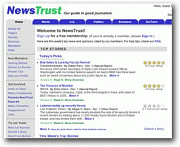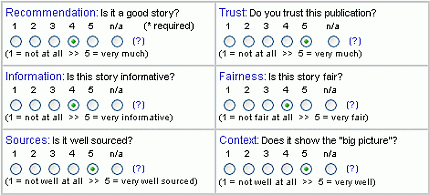NewsTrust: quality is not the main thing
 You do not need to have a special gift of insight to see one of the main trends in the development of the Network: every month it becomes more and more difficult to find the necessary information on the growing Internet, because the layer of noise hiding it is becoming thicker and denser.
You do not need to have a special gift of insight to see one of the main trends in the development of the Network: every month it becomes more and more difficult to find the necessary information on the growing Internet, because the layer of noise hiding it is becoming thicker and denser.Already, many people agree that in the very near future, the central nodes of the World Wide Web will be resources that act as a filter: finding interesting materials against the general motley background of advertising sites, personal blogs and traditional media that are frantically searching for their lost path. These sites include resources like Digg and Reddit, as well as search engines that adapt to the trends of time, complicating their algorithms to an almost intellectual level.
However, both types of filters have one major drawback, directly arising from their main advantage: by sorting and selecting the most interesting information based on its popularity alone, they regularly run into dangerous pitfalls.
')
The core of social news filters is made up of people, regardless of the breadth of their horizons, who have their own subjective opinion and, in most cases, unite into groups precisely on the basis of the coincidence of this very opinion. As a result, even on the millionth Digg, we often see frankly unreliable news on the main page, only because the “facts” presented in them were liked by many. On one of the latest high-profile examples - the news that Sony, allegedly, officially surrendered to Microsoft in the fight game consoles, can be read here .
Search engines are even more vulnerable to the effects of such a rush, as controlling the accuracy of the information referenced by hundreds of sites is damn harder for them.
Many want to solve the problem, but the most successful so far, in my opinion, the solution is now being embodied in the NewsTrust project . Former journalist and employee of Apple and Macromedia, Fabrice Florin ( Fabrice Florin ) came up with a simple idea in its genius. Each material is evaluated using the old as the world of a five-point system for each of the 6 parameters: general recommendation (is the news worth attention at all), credibility of the news, information content, impartiality, validity (quality of primary sources of information), clarity of context (is the complete picture). As a result, when estimates from a sufficient number of users accumulate, their average value in the form of asterisks is displayed next to the heading of each news item. You can later change your rating as many times as you like.

There are two advantages to this approach. Firstly, before evaluating the material (this process is even called “to review” on NewsTrust, which is much more significant than just voting), the user is given enough reasons to start taking a sober look at things. And secondly, visitors to the resource can be absolutely sure that in the main news feed they will see the latest, written in literate language news, or, according to Florin, the product of “quality journalism”.
The project's business model is generally ordinary: advertising, donations from well-wishers and the provision of services to companies interested in obtaining an objective public opinion about themselves.
Source: https://habr.com/ru/post/4844/
All Articles